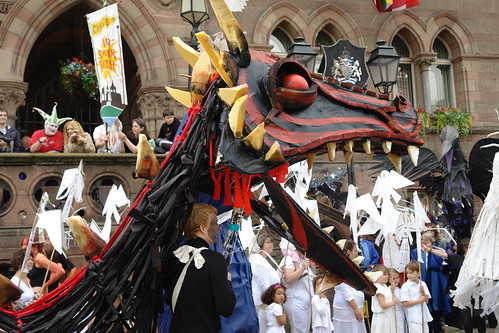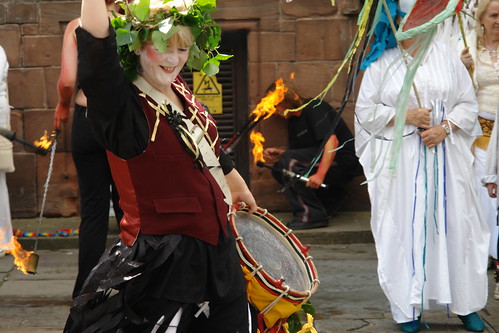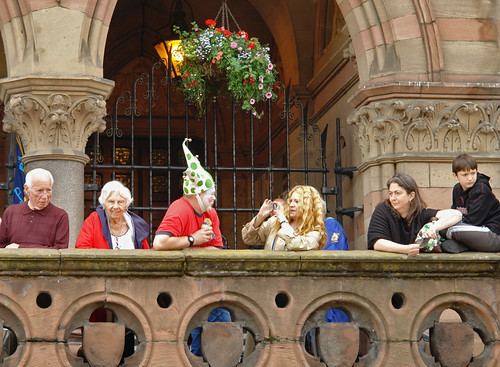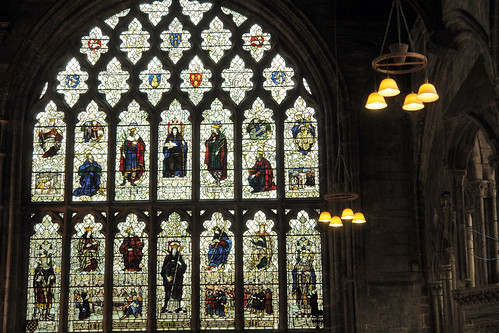Published in Mint Lounge – May 31 – read it online here or the pdf version here…
We are just finishing a salad lunch at the tiny restaurant opposite the library when the dragons walk past. A bright red patch on a black face, a black-and-red body, head waving in a friendly fashion. A fairly amicable dragon, as dragons go. A large wooden elephant follows, a man’s face peeping out tentatively from inside a crate on its back. Behind that, a bunch of little fairies dressed in pristine white, with identical “don’t-mess-with-me” looks on their faces.
And just then, a little boy, a pair of white trousers in the midst of all the frocks, turns to the girl next to him and sticks out his tongue at her. For a moment, there is a frisson of unrest among the fairies but hard discipline kicks in, overriding the attractions of a street brawl.
The ever-informative Wikipedia says: “In 1564 the Midsummer Watch Parade (in Chester) included 4 gyants, 1 unikorne, 1 dromodarye, 1 luce, 1 camell, 1 dragon, 6 hobbyhorses and 16 naked boys.” The naked boys have gone into hiding, but most of the others are still around at the parade: giants, dragons, camels and dromedaries (the single-humped camel), hobbyhorses (and elephants). Huge floats convey the dragons and the sun and the moon and several stars, little girls dressed in lacy white frocks, old men and women in blue fancy suits, and tall men on stilts making them taller still. And jugglers and fire-eaters and drummers marching to their own beat. Perhaps the luce, too, whatever it is.
The Midsummer Watch Parade at Chester is a ritual believed to have begun in 1498, according to the city council, with “the outstanding features of the show (being) the Giants—enormous structures made of buckram and pasteboard and carried by two or more men”. Somewhat disturbingly, the naked boys featured even then: “There were also fantastic giant beasts including the unicorn, the elephant, the camel and the dragon. Originally the dragon was beaten by six naked boys, but this practice was banned in the late 16th century”. There’s something to be said, then, for Elizabethan morality.
Today, the parade is one of Britain’s largest and most colourful street carnivals. But there is no sense of anticipation, no eager waiting crowds, in fact, no major indication that such a parade is about to take place, except for the posters all over town. One minute, all is quiet on the streets, with just a few tourists craning their necks to see the well-preserved Tudor buildings lining the streets. And the next, dragons and drummers are out in full force, and the streets are chock-a-block with people.
Midsummer’s eve, associated with summer solstice and the longest day, has been celebrated in various ways from ancient times, from worshipping the healing powers of the sun’s rays (a reaction, perhaps, to the bitterly cold winter months) to lighting bonfires through the night to keep evil spirits away.
Superstition finds its natural home in midsummer, when any kind of madness is possible and, in the hands of Shakespeare, the queen of the fairies gets besotted with an ass-faced pleb, and young couples fall in and out of love at will (and sometimes against their will). The rituals have changed slightly down the years, but midsummer is often still considered licence for the laity to slip on fancy dress, blow trumpets, drink copiously and make merry.
The history of Chester goes back even further, to the times when Romans came, saw and conquered their way through Britain, leaving behind walls and wells for later-day tourists. History has it that all towns with “chester” in their name (the Roman castrum, meaning fortified city or camp, was corrupted to “chester” and “caster”, as in Colchester, Winchester and Doncaster) had been occupied by the Romans, though Chester itself was originally named Dewa (or Deva), after the spirit of the river Dee. Chester was ideally situated—on a high promontory, overlooking a fine harbour and a navigable river—for the conquest-minded; today the river is one of the most pleasant places in Chester, the perfect spot for a Sunday afternoon rendezvous.
When I reach the boat pier, the local deaf choir is performing on the banks of the river, the eyes of the participants moving in time to the swaying hands of the conductor. Couples and families are walking about with their ice-cream cones as we touristy-types noisily queue up for the boat ride. I spot several familiar faces, co-cheerers from the watch parade. In some ways, this scene is as colourful as the parade itself: buskers playing their guitars, street artists offering to sketch you or trying to sell their works of art, boisterous merrymakers waving their hands from the passing boats.
On the large boat, the discomfort of the hard wooden seats is soon forgotten as the countryside unfurls, and we pass picturesque little houses, each of which has a boat and tiny landing pier, and each of which I desperately want to own. The ride itself is a bit like being inside a poem; I mean, do you really ever expect to see daffodils fluttering and dancing in the breeze?
Perhaps, to emphasize those literary connections, the city hosts the Chester Mystery Plays this summer (28 June-19 July). Performed once in five years on the streets of Chester, the plays are dramatizations of biblical stories that portray the role of God in man’s life and are not—as I imagined—suspense dramas of The Mousetrap school. These plays, which date back to the 10th century, were banned by the English church in the 16th century, to be revived only in 1951 for the Festival of Britain, a feel-good event organized for the war-battered populace.
But for all that, it is the Midsummer Watch Parade that is the key attraction of Chester (21-22 June this year). And, not surprisingly, the local government takes it very seriously, going by the ads that have been up on their website (www.chester.gov.uk/tourism_and_leisure-1/festivals_and_events/midsummer_watch.aspx) for a few months now. “Wanted… Angels, devils, fiery goblins, green men…to take part in Chester’s spectacular Midsummer Watch Parade.”
If you have it in you to be a green man, or a goblin, you know where to apply.
TRIP PLANNER
How to get there:
You will need a UK visa to go to Chester. The British high commission in India issues tourist visas (known as visit visas) within three working days for Rs5,500.
Fly from any large metro in India to London on British Airways or Jet Airways. Round trip economy fares range between Rs32,000 and Rs38,000. From London Euston, Chester is roughly three hours by train or road. Alternatively, fly into Manchester or Liverpool and take a cab to Chester, barely 40 minutes away.
Where to stay:
It is best to visit Chester as a day trip from London or stop over en route to Wales. Stay at the Broxton Hall, close to Chester as well as the Snowdonia National Park in North Wales. Broxton Hall is a Tudor property, spread over 5 acres. Rates start from £75 (around Rs6,220) for single rooms with breakfast, going up to £140 for suites. Alternatively, the Chester Grosvenor is located in the middle of town and has excellent reviews.
What to do:
In Chester, take the 1920s vintage open-top bus tour that comes with a driver and guide, fully-costumed in Victorian wardrobe. Or, walk around over the ancient walls encircling the town, stretching for just over 3km. There are city wall walks available for those interested in covering them completely; I just climbed up and walked on the walls, getting down to explore wherever the fancy took me.
The Chester Cathedral, which attracts more than a million visitors every year, is also a must-visit. Records show a church on that spot since the early 10th century (AD 907), though this cathedral with its stunning stained-glass windows was built sometime around 1092. Also worth visiting, is the Chester amphitheatre (capable of seating 7,000 spectators in its time), regarded as Britain’s finest and still the base for the Roman Changing of the Guard festival, which takes place once a month.
Everything about the town is quaint. Chester is, I am told, the only place where the world’s first—and perhaps, only—husband and wife Town Crier partnership still operates. David and Julie Mitchell carry out midday proclamations through summer (May to August) at the High Cross, where this tradition has been alive since the Middle Ages.
Chester also hosts an annual literature festival in October, highlighted by a book-swap: bring a book and take back another!
***
More photos from Chester and the parade here on flickr…










I was in chester last month and I would say quaint would be the perfect word to describe this town. Walking the ancient wall provides a great view of the town.
In the summer the horse track really gets going too!
Im really pleased to see that you made it into an article. The Watch parade still remains relatively unknown among large portions of chester, let alone the wider world.
I would obviously encourage as many people to volunteer as possible as we are in great need of banner holders and i refuse to leave my position as devil princess.
You might also be interested to know that we also hold Midwinter watch parades which are only slightly different being smaller and more snow-orientated 🙂
Great blog you have here!